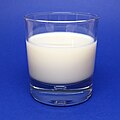Pathogen reduction using riboflavin and UV light is a method by which infectious pathogens in blood for transfusion are inactivated by adding riboflavin...
9 KB (1,107 words) - 17:40, 28 May 2025
Blood-borne disease (redirect from Blood-borne pathogens)
technique that uses a combination of riboflavin and UV light to inhibit the replication of these pathogens by altering their nucleic acids can be used to treat...
23 KB (2,415 words) - 02:26, 26 May 2025
Virus inactivation (redirect from Pathogen inactivation)
United Kingdom. E Silva and AM Edwards, editors. Kumar V, et al., "Riboflavin and UV-Light Based Pathogen Reduction: Extent and Consequence of DNA Damage...
16 KB (2,195 words) - 03:14, 26 May 2025
In terms of the use of photosensitizers, both methylene blue and riboflavin are employed for the photodisinfection of plasma, using visible or long-wave...
109 KB (11,391 words) - 03:13, 16 June 2025
Blood transfusion (redirect from Cross and type)
cytomegalovirus infection, and platelet-transfusion refractoriness. Pathogen reduction treatment that involves, for example, the addition of riboflavin with subsequent...
130 KB (14,220 words) - 16:54, 25 June 2025
Platelet (redirect from Light transmission aggregometry)
minimize risk. Pathogen reduction of platelets using for example, riboflavin and UV light treatments can reduce the infectious load of pathogens contained...
71 KB (8,529 words) - 20:44, 19 June 2025
Melanin (category Pages using the Phonos extension)
rather than absorbing light, pheomelanin within the hair and skin reflect yellow to red light, which may increase damage from UV radiation exposure. Pheomelanin...
63 KB (6,750 words) - 05:10, 24 June 2025
Basil (category Pages using Sister project links with wikidata namespace mismatch)
cuttings to blue light significantly accelerates root formation, thereby shortening the growth period. Basil suffers from several plant pathogens that can ruin...
39 KB (4,015 words) - 19:11, 23 June 2025
Plant physiology (section Signals and regulators)
specific wavelengths of light. Plants use four kinds of photoreceptors: phytochrome, cryptochrome, a UV-B photoreceptor, and protochlorophyllide a. The...
30 KB (3,557 words) - 04:44, 1 June 2025
Lettuce (category Pages using Sister project links with wikidata mismatch)
Growth, and Survival of Pathogens in Fresh and Fresh-Cut Produce". Analysis and Evaluation of Preventive Control Measures for the Control and Reduction/Elimination...
57 KB (6,162 words) - 13:05, 26 May 2025
are used for autoinduction during quorum sensing. The Photobacterum operon type is characterized by the presence of rib genes that code for riboflavin, and...
49 KB (5,609 words) - 21:40, 22 May 2025
Hemp (redirect from Cannabis (industrial uses))
the world. Because of its low UV-resistant rating, the finish is most often used indoors, on surfaces such as flooring and wood paneling. Hemp-based insulating...
138 KB (14,332 words) - 17:11, 6 June 2025
Milk (category Pages using multiple image with manual scaled images)
transparent or highly translucent containers are now using thicker materials that block the UV light. Milk comes in a variety of containers with local variants:...
153 KB (15,818 words) - 03:14, 24 June 2025
Bacillus subtilis (section Uses)
for B. subtilis to repair its DNA damage, experiments were conducted using UV light as the damaging agent. These experiments led to the conclusion that...
54 KB (6,333 words) - 05:53, 28 June 2025
Thraustochytrids (section Potential uses)
activating non-specific immune responses, cancer remedies, UV ionization cell damage reduction, and the capability of acting as an exogenous antioxidant. Thraustochytrids...
110 KB (10,931 words) - 22:21, 29 May 2025












